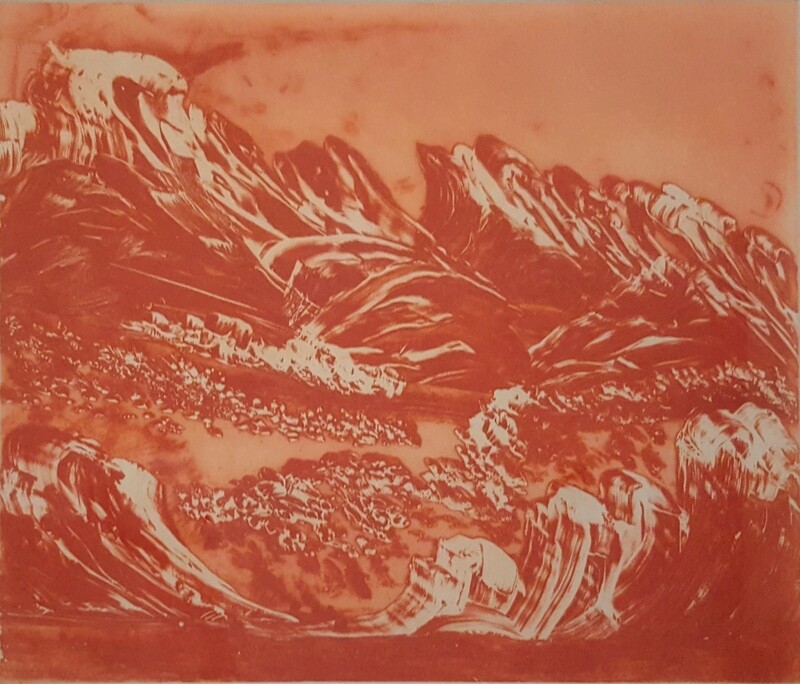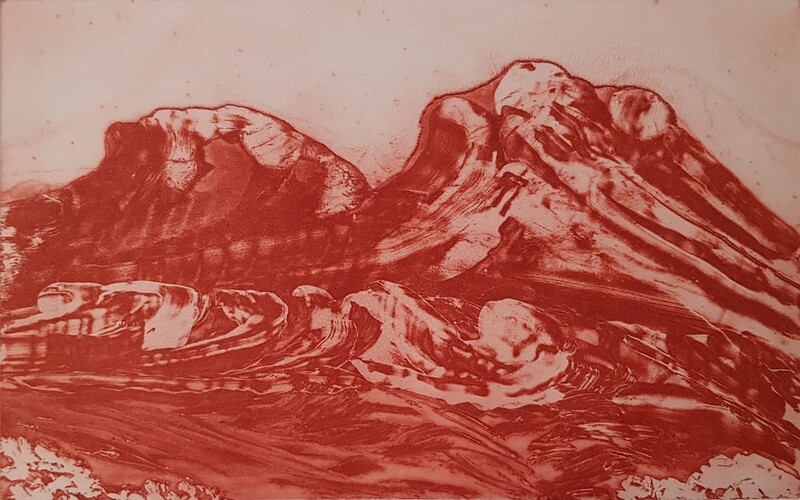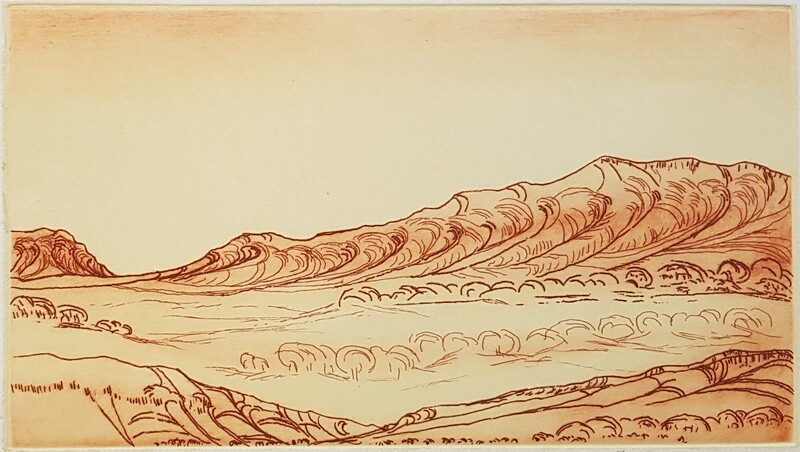Billy Benn Perrurle
Billy Benn is a landscape painter from Atitjere (Artetyerre / Harts Range) in Central Australia. He primarily paints the country passed to him through his Alyawarr father and his Akarre mother. He has worked since 1981 for the human rights organisation Bindi Inc. in Alice Springs. In the 1990’s, during his breaks from making metal tucker boxes, he started painting on off-cuts of timber and metal. The Mwerre Anthurre Artists collective was founded around his talent in 2000.
Catherine Peattie
Born in 1943 in Artetyerre (Harts Range), Billy Benn’s two older sisters Ally Kemerre and Gladdy Kemerre, both celebrated artists of the Utopia community, taught Billy how to paint on skin when he was a teenager, while living at Kurrajong/Urapuntja (Utopia). Their father was also an artist, who made the more traditional artefacts, wooden sculptures, boomerangs and spears. Jimmy Kemerre worked in the Mika mines and also mined for gold out at Altunga, transporting people and mail from Alice Springs to Altunga by camel whilst working for a man, Simon Reef.
In the book Billy Benn by Billy Benn Perrurle and Catherine Peattie…
Billy also remembers a Chinese lady named Jane showing him how to paint. Mrs Mark Mitchell, ‘Jane’, was the Chinese wife of one of the non-Aboriginal miners. She was particularly fond of Benn and taught him to paint with watercolours and with the traditional Chinese brushstrokes. This tutelage ha a profound influence on his layering of colours and by elongated rolling ridgelines and dramatic crevasses. Benn’s technique is graceful and certain, creating an emotional resonance respected in Chines painting traditions. A tendency towards an asymmetrical composition of the landscape is also a feature of his work….
(extract from Billy Benn by Billy Benn Perrurle, Catherine Peattie)
This influence is mentioned from the same publication in the essay Imagination and Reality: The Visionary Landscapes of Billy Benn by Judith Ryan… Dr Mae Anna Pang, a specialist in Chinese ink paintings of the Ming and Qing Dynasties, says of Benn’s work:
The paintings… are amazing. They appear like dreams as well as memories or visions. He paints from memory, like the way the traditional Chinese artists did. The approach is interesting, different from the Western approach of painting in front of the scene. The brush movement is also interesting. Colours are used almost like tonalities of ink in ink washes. I think he captures the soul of the Australian landscape.
As Judith Ryan notes in her essay,
Benn’s works feature the music of the brush, used in a painterly rather than linear manner to evoke rather than carve out topography; they often rely on interactions between solid forms and negative space, occasioning ‘aesthetic emotions analogous to those of music that bear comparison with Chinese ink painting and calligraphy….
Billy has worked extensively in his country. He began working as a young boy, aged approximately 10, in the Mika mines of Harts Range with Simon Reef’s younger brother Norman. He recalls alot of Italian people working there, and the large flagons of wine they carried with them, imported from Italy. He recalls the lunches of spaghetti….” Good food, those Italian people
“… Billy was not paid for his work, instead receiving tucker and clothes. Later Billy began pumping water for cattle, again being paid in flour, sugar and tea. He spent most of his working life in the North Eastern area of Central Australia droving sheep and cattle for Pastoralists Cameron Chalmers, Joe Mangel and Peter Hayes. It was whilst working with Chalmers that Billy grew up to be a man. Billy speaks in particular of a special trip, droving with his cousins from Arrkngenangkerre (Mount Swan), where they drove a herd of cattle to deliver to Neutral Junction Station, East of Barrow Creek, also returning on horseback.
Since 1981, Billy worked at Bindi Inc since 1981, an organisation established to provide employment opportunities, support and advocacy for people with a disability in Alice Springs. During his time constructing metal boxes in the Brown Street workshop, he identified a space which became his corner to paint in. Billy began to visually map out his father’s country via the painted image, using old boards discarded by the Alice Springs Timber Mill. Working as many ‘outsider artists’ do, with second rate materials, on any surface that appealed, Billy painted using his fingers, cloth, glue and paint. Despite the brilliant landscapes being created, they were only shown once prior to 2000 in an exhibition of artworks done by people with a disability in the “ Beyond Passions ” exhibition in Alice Springs. All his work sold, and yet, the low profile of the exhibition, meant that his work had still not been viewed by the wider market.

Billy Benn - In The Bush Barrow Creek Way c 1996 - Size 244.3 x 30 cm - Source: Art Gallery of NSW, Sydney
Benn’s paintings remain true to their origins, created on salvaged timber and, early on, were often embellished with generous coatings of estapol. Awareness of Benn’s work grew when ‘ In the bush Barrow Creek way, ’ c.1996, appeared in ‘Desert Mob 2001’, one of the annual expositions of regional Indigenous art held at the local Araluen Arts Centre in Mparntwe. Widely regarded as his most spectacular work, it is likely this painting was inspired by Benn’s fond memories of droving with his cousins from his father’s country Arrkngenangkerre (Mount Swann) to Barrow Creek.
Source: Hetti Perkins in ‘Tradition today: Indigenous art in Australia’, Art Gallery of New South Wales, Sydney, 2014
Unable to return to his homeland, Billy continued to paint primarily his father’s country of Mount Swann and his own country, Harts Range. His images are found from memory and feeling, by painting his land Billy brings the country into himself. He plans to paint every hill from his country and then he will stop, then he will return home. The artist’s traditional life and history remain intensely important to him.

Billy Benn - Artetyere, 2006 - Acrylic on linen - Winner of the The Alice Prize 2006
This Alice Prize winning work by Billy Benn Perrurle carried the caption:
“He wants to paint every hill from his country and then he will stop, then he will return home.”
Billy’s paintings cover a wide scope of style, born of his own lack of preciousness, his vivid imagination and colour, texture and material experimentation strategies - rather than the study of other painterly influences. One sees hints of Turner, Cezzane, Van Gogh and the Orientalists within his work, yet these were images never seen by Billy. We are reminded of these other great painters in the variations of light that he captures, rolling ranges painted in deep reds, reminding viewers of the raging seas Turner exposed. From the Central Australian context, they remind one of the great inland sea which once existed here. Yet Billy remarks only on Albert Namatjira being a great painter.
Billy’s paintings communicate a well-informed knowledge and relationship of the space that exists in this country. Belgian Art Historian, Georges Petitjean, was excited by Billy’s breadth and continuance of horizon, never curving at the edges but continuing their travel overland and on into the distance.

Artetyerre, 2007 by Billy Benn Perrurle (listed in publication Billy Benn, by Billy Benn Perrurle, Catherine Peattie (IAD Press), ISBN 978-1-86465-116-4
As one of Australia’s most beloved ‘outsider artists’, it is no small wonder that Billy Benn’s work has attained such a significant and unique place in the Aboriginal art market. Since joining Bindi Inc in the early 80’s, he had been painting his father’s country, working from memory to create a visual map of country that he has not seen since a boy. He first showed with the Araluen Arts Centre, Alice Springs in 2000.
Billy’s work is now included in many outstanding collections such as the National Gallery of Victoria, the National Gallery of Australia, the Art Gallery of New South Wales and the Museum and Art Gallery of the Northern territory as well as many private collections throughout the world.
His landscapes are typically wild and woolly concoctions of rolling hills and naive foregrounds. For most collectors, Billy’s work holds a special place and his works are consistently thought to be gemlike in their appeal, small, precious and something to be treasured.
Gallery Gondwana




